|
TennisOne Lessons
The “Advanced Foundation”Advancing to the Next Level!By David W. Smith (Excerpted from his book, Tennis Mastery, due out in early Fall, 2003) Tennis, perhaps more than any other sport, has two distinct “classes” of players: in one court there are those who progressively improve and reach what is generally recognized as “accomplished” or “skilled” levels of play. On the other side are those who learn basic skills, then promptly stagnate at a particular ability level, usually at the 3.0 or 3.5 NTRP levels. (To those just starting out, the NTRP—National Tennis Rating Program—levels go from a 1.0 beginner to a 7.0 professional.) To the untrained eye or to an inexperienced individual this distinction of two classes may be difficult to recognize. However, there are countless tennis players who have played for years, if not decades, who have not advanced significantly!
Of the 12 million tennis players in the United States more than three-quarters seem to reside permenantly at the 3.0 or 3.5 level or below. This statement is not meant to offend anyone or insinuate that players at these levels are incapable of playing high-level tennis. On the contrary, it is my intention to prove that virtually all players, including those who currently reside at the 3.0 or 3.5 levels, are indeed perfectly capable of playing higher levels of tennis… much higher! This distinction of two classes of players has created an identifiable vernacular within tennis circles. Players refer to “The Big Four-O (4.0 NTRP level)” as being a major stepping stone, a hurdle one needs to vault in order to be recognized as a skilled player. Countless 3.5 level players spend millions of dollars each year in search of ways in which they can “break through” this 3.5 barricade. The question is why do some break through while others have to resign themselves to “mediocrity” for life? (With the NTRP levels starting at 1.0 and topping out at 7.0, the levels 3.0 and 3.5 are technically considered below average on this scale. Because so many players are stuck at these levels, many consider these levels to be “average!”) Many variables can account for such stagnation including lack of desire, lack of natural athleticism, limited playing opportunities, or a lack of available tennis information. However, it is interesting to recognize that the majority of those players who stopped improving did indeed have similar desires, adequate athleticism, an access to tennis information, and similar playing opportunities to those who continued to improve. If these things are indeed similar between the two classes of players, what factor can be identified as the decisive divergent mechanism? If all things are considered equal, then the answer becomes quite evident. The only recognizable variable, which in this case is indeed a variable, is information! As I have suggested in my Advanced Foundation Series of articles, a player who wishes to reach higher or more skilled levels of play must resist the urge to learn (or be taught) simpleton or interim methods in order to gain immediate gratification, for these simpleton techniques must be changed if the player hopes to attain more advanced levels of play. Such rudimentary learning, for the sake of quickly being able to “play” tennis is most detrimental to players in reaching their tennis potential. However, there is one additional factor that must be understood if the player ever hopes to actually play at higher levels of play.
The Comfort Zone SyndromeWhen a player has learned inferior strokes at first, (or has had minimal experience trying proper strokes), then makes a dedicated effort to change, we observe these students often falling back on their mediocre strokes in the heat of any competition. Watch almost all players compete; whether we are talking tournament play, league play, or even relaxed social play, such players will always play within the strokes and strategies they are most familiar with. Even when players understand the form they should be using, these players almost always and immediately go back to their inferior—but comfortable stroke patterns in various playing situations. (Comfortable because they learned these mediocre strokes first!) I call this tendency to revert back to this inferior—but comfortable—pattern of play the “Comfort Zone Syndrome.” (I probably should call it the comfort zone “plague” since it affects so many players attempting this pattern of change!) A player, who continues to only use rudimentary form on strokes such as serves and volleys, or any other inferior form in match play, will never advance. I think it is obvious to any student of the game—regardless of experience—that repeating strokes/form/technique, which are prohibitive to improvement, will prohibit any substantial improvement in their game! If the goal is to become a more skilled, competitive tennis player, this pattern of inferior play—at the expense of the more desirable technique or strategy—must, at some point, be discarded.
So, You Want to Be a 5.0?Tennis players of all abilities and those seeking higher levels of skill (and thus a higher rating) must understand this very simple but very true statement: “If you never make an effort to create stroke patterns that are decidedly at higher levels of play, you will never reach those higher levels of play you seek.” This statement is critical on three points. First, players must be willing to make errors while attempting more advanced form. Second, players must clearly understand what advanced form is. Third, they must know how to attempt it themselves, (especially without falling back to old stroke habits in the process.) Let me break down these concepts so players can clearly understand how they relate to them personally. Players Must Be Willing to Accept ErrorsWhen a player attempts more advanced stroke patterns, some element of failure is inevitable. Yet, failure must not discourage future attempts! Consider the toddler trying to walk for the first time. Failure (in falling) is a given. Yet, we as wobbling infants get up and try again and again…until we are actually walking. Tennis players must keep attempting more advanced stroke patterns regularly in competition and in practice if they ever hope to reach such skilled levels of play. If we as toddlers reverted back to the safety and comfort of crawling the first time we failed at walking, we would probably find ourselves on all fours playing tennis!
If we sincerely want to achieve high levels of play, we must continue to attempt such advanced stroke patterns even if it involves losing to many of the players we use to beat (and losing to those players while changing stroke patterns is inevitable, however temporary.) I am not talking about attempting to hit beyond a logical level of advance play. The Advanced Foundation provides the proper technique attainable by all students, yet it is not stagnating as most transitional methods are. Millions of tennis players, when attempting what they know is the correct serve, volley or groundstroke go right back to that which is comfortable and safe. (And then they wonder why they never get past the 3.0 levels of play!) Advanced stroke patterns can include both stroke mechanics that are deemed “advanced” as well as stroke patterns that are more effective through their application (such as greater spin, angle, depth, pace, etc.). Player personalities can contribute to the likelihood of such higher-level attempts. For example, an extrovert (usually a young male!) often goes for more shots or greater difficulty in shots than they are usually ready to do. While this premature effort often leads to disaster, these same players, when working within stroke mechanics deemed proper, eventually master such high level strokes just because they are constantly attempting them. On the other hand, a very conservative individual might never attempt anything out of their comfort zone. Thus, they languish at mediocrity; their level of mediocrity is determined only by the level of comfort they possess within their perceived conservative play.
Players Must Understand What Advanced Form IsSimply swinging harder or aiming for severe angles will seldom lead to consistency or success for any individual. (Swinging harder is seldom part of the Advanced Foundation. However, players who develop the Advanced Foundation will indeed begin to naturally swing harder with greater success and consistency.) Without swinging within defined and proper stroke patterns, the likelihood of mastering any shot is practically impossible no matter how many times it is attempted. This is because most wild or extreme strokes are seldom repeatable within the vast diversity and location of our opponent's shots. Thus, it is paramount that players know what advanced form is and how it applies to each shot attempted. This is where lessons, books, videos, and/or simply watching tennis on television or in person can be of such help. Without having a clear understanding of all tennis strokes, it is highly unlikely a person will spontaneously hit tennis balls with advanced form. Players Must Know How to Attempt Advanced FormUnderstanding and knowing what specific strokes and shots look like is one thing. It is another thing to know how to physically reproduce them. Through my years of training players, I can say without a doubt, that every single player has a different baseline level of kinesthetic control of their own bodies. Therefore, some players must be more disciplined and patient in their development of strokes, while others can mimic and replicate exactly what they see and understand almost immediately. And players who have played many years using inferior form will be most pressed into first overcoming prior stroke tendencies before proper and, then, advanced stroke patterns can be instilled and mastered.
Players must understand the desired stroke pattern as well as understanding what their body and appendages are doing. A number of players to whom I have been exposed actually thought they were hitting topspin when in fact they were hitting a slice! Certainly, if a player has not developed the necessary comprehension of personal movements of body parts, then executing strokes deemed proper will be most difficult. Adjustment PeriodWhen beginners play, they will play within a performance pattern that is comfortable. Since they have minimal understanding or experience in stroke development, they can only do what they “feel” is correct. Obviously, if skilled form is foreign or uncomfortable, a beginner will seldom explore such form—at least not with conscious effort! This concept alone clearly contradicts those teachers who believe in letting players blindly explore the game through self-discovery or within passive explanatory means. While skilled players play within a methodology that appears “simple,” (or as many often say, “they make it look so easy!”), the actual methods that lead up to such simple stroke patterns are not natural, comfortable, or simple to most people. As in any sport, the practice of proper technique and the experience of employing such technique in competition will eventually make the difficult become simple and the foreign become second nature. Avoiding those methods will not speed up this process in the least! In fact, avoidance of any technique that is deemed proper will prevent acquisition of such technique! Players in competition to tend fall back on old strokes and form, that which is most familiar. As with most intermediate players, the most familiar stroke pattern is the way they first learned the game. If this pattern is based on inferior, mediocre methods, than the player will indeed revert back to inferior and mediocre strokes.
In either case, players must understand three things:
“Good Mistakes”It is far better for players to use the best form they have been taught, and make mistakes with those strokes than it is to continue using simple or inferior strokes and perceive some idea of success. (That is if they indeed want to become skilled tennis players!) I say, “perceive” because players can actually make more mistakes with their old, inferior strokes and feel more successful than when making fewer mistakes with new, more advanced strokes. This perceived success (within such failure) is due to familiarity. Typically, when players start trying to use new strokes, the unfamiliarity creates discomfort and uncertainty. For many players it is more comfortable to miss with shots with which a player is familiar than to make successful strokes using something new and unfamiliar! This is why players must understand that an “Adjustment Period” will need to be tolerated while using proper form. Even when a player applies proper form, mistakes often occur. These can be caused by:
As you can see, there can be many incriminating factors that can produce an unsuccessful shot. Thus, a player must understand that while many components of a shot can be correctly executed, one or more other stroke-components might be off or wrong… producing an unsuccessful result. I can't tell you how many times I have heard a student say, “I did what you told me but the ball still went out.” Teaching pros around the world can all probably attest to this! And we can easily see from the description above just why a player can actually do almost everything right…yet still not have the desired outcome! However, there is hope!With every mistake using proper form comes learning. For example, if a player is trying a new two-handed backhand and hits it into the net or long, a realization of racquet control and body movements is initiated. Each succeeding hit will ingrain the understanding of what the racquet and body is doing in conjunction with each hit. Each time we revert back to inferior form, we prohibit what we are trying to accomplish in favor of accomplishing what we are trying to eliminate! Tennis is probably the only sport that has the word “dinker” as part of its jargon. The word itself describes quite accurately the style of play or strategy such a player enlists. Why is it that the sport of tennis is essentially the only sport relegated to such a playing term or tactic? Next time, I will explore the underlying principles that contribute, almost entirely, to this strategy. David has taught over 3000 players including many top national and world ranked players. He can be reached at acrpres1@email.msn.com. |
|||||||||||||||

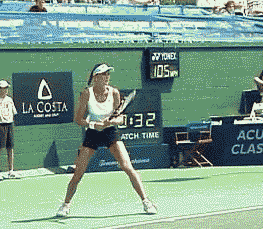
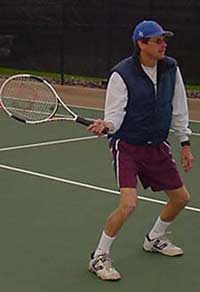
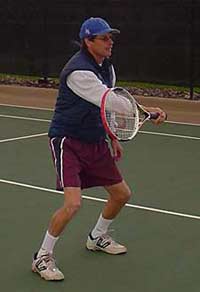
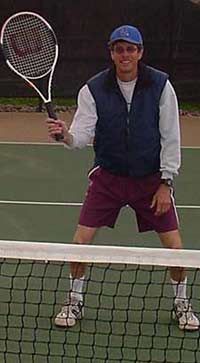
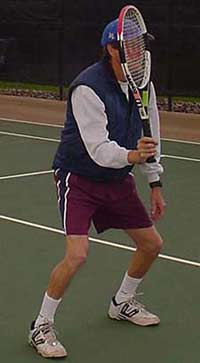
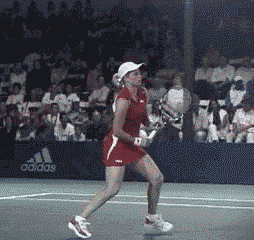
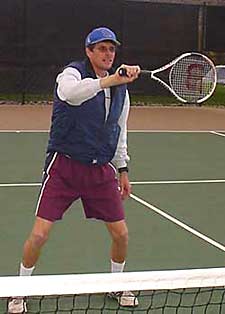
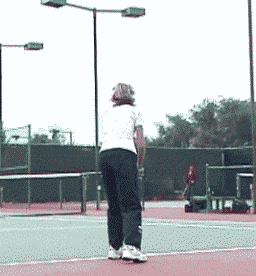
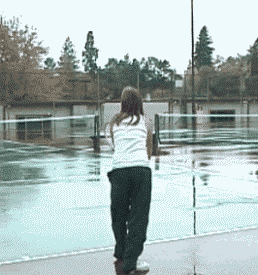
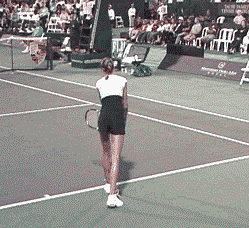
 Your comments are welcome. Let us know what you think about this article by
Your comments are welcome. Let us know what you think about this article by